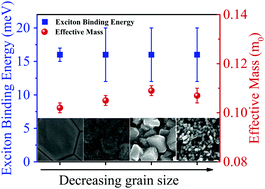Impact of microstructure on the electron–hole interaction in lead halide perovskites†
Abstract
Despite the remarkable progress in the performance of devices based on the lead halide perovskite semiconductor family, there is still a lack of consensus on their fundamental photophysical properties. Here, using magneto-optical transmission spectroscopy we elucidate the impact of the microstructure on the Coulomb interaction between photo-created electron–hole pairs in methylammonium lead triiodide (MAPbI3) and the triple-cation lead mixed-halide composition, Cs0.05(MA0.17FA0.83)0.95Pb(I0.83Br0.17)3 (Cs: cesium, MA: methylammonium, FA: formamidinium) by investigating thin films with a wide range of grain sizes from tens of nanometers to microns. At low temperatures, in which thermal fluctuations of the interactions are frozen and the rotational disorder of the organic cation is negligible, the exciton binding energy and reduced effective mass of carriers remain effectively unchanged with grain size. We conclude that the microstructure plays a negligible role in the Coulomb interaction of the photo-created electron–hole pairs, in contrast to previous reports. This renewed understanding of the relationship between these fundamental electronic properties and the microstructure is critical for future fundamental studies and improving device design.

- This article is part of the themed collection: 2017 Energy and Environmental Science HOT articles


 Please wait while we load your content...
Please wait while we load your content...